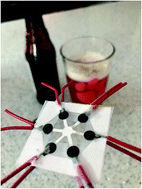Carbon tape as a convenient electrode material for electrochemical paper-based microfluidic devices (ePADs)†
Abstract
Electrochemical paper-based analytical devices represent an innovative and versatile platform for fluid handling and analysis. Nevertheless, the intrinsic structure of the paper can impose limitations to both the selection of the electrode material and the method selected to attach the electrodes to the device, potentially affecting the analytical performance of the device. To address these limitations, we herein propose carbon tape as a simple and low cost alternative to develop ePADs. The proposed material (in the form of tape or tabs) was first characterized using a combination of contact angle analysis, resistivity, Raman spectroscopy, cyclic voltammetry, and electrochemical impedance spectroscopy. Upon this initial assessment, carbon tape was selected and modified with carbon nanotubes, to provide not only a better surface for proteins to adhere to, but also an enhanced electroactive surface. The analytical performance of the resulting device was assessed by integrating three enzymes that facilitate the oxidation of ethanol, glucose, and phenol, and by performing the detection of these analytes in beer samples. The resulting device, for which materials cost less than a dollar, represents a simple alternative material for ePADs, applied in this case to monitor three of the most important parameters during the production of beers.

- This article is part of the themed collections: Analytical Methods Recent HOT articles and Microfluidic systems with societal impact


 Please wait while we load your content...
Please wait while we load your content...